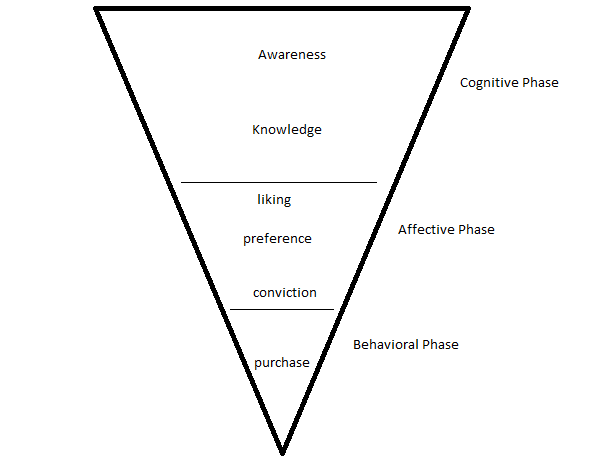There are many advertising theories that show how the advertisement of products should be carried out (Mecca 2011). Among all these theories, the order of effects remains the same. In advertising, the sequence or the order of effects is commonly known as the hierarchy of effects. These are the activities that can be explained using a pyramid, as they start from the lower level, i.e. awareness to purchase level which progresses from subsequent objectives. This hierarchy of effect starts with awareness, knowledge, liking, preference, conviction, and purchase (Mecca 2011).

Awareness
In the first place, consumers cannot purchase products that they are not aware of. The producer must make the product known to his targeted market audience when it is introduced to the market for the first time. This targeted market may be from the market segment of his choice with regard to the nature of his product(s). The brand name of the product should be made focal to the potential buyers, but not capture the attention of the potential buyer only.
Knowledge
Final buyers will have to know the meaning of the brand name. This involves the act of creating brands awareness. At this level, the potential buyers of the product have to know the appeals of the product and the main benefits retrieved from them. Consumers also need to know how the new product is different from the competitor’s brands.
Liking
The next stage involves carrying out an outside-in strategy to find out how the targeted consumers or users feel about the product. This involves finding out if targeted buyers like the product. If they appear to react unfavorably to the product, the producer or the communicator should find out why. If the product’s problem can be rectified, it should be fixed and the renewed version of the product should be communicated.
Preference
The preference of a product by the people varies from person to person. The targeted buyers may like the product but fail to prefer it to the existing products (Mecca 2011). This makes it necessary for the salesperson to improve the consumer’s preference by quality, the value of the product, performance of the total product, packaging which seems beautiful and attractive to the consumers, among other consumer preferences. The act or campaign of making the product known and it success can be measured using the measurement of consumer’s preference. This measurement may be done before the commencing of the campaign or after the campaign has been carried out.
Conviction
Consumers may have a predisposition in favor of the product but lack the unshakeable trait in purchasing the product. The communicator of the product is responsible for convincing the consumers to buy the product, on behalf of the producer.
Purchase
The targeted consumers may be convinced to buy the product but end up not purchasing the product. This is because of the different reactions of the consumers; some may be waiting for much information regarding the product, while others may plan to respond later on the product (Mecca 2011). Consumers are really helpful in the final step taking, hence the communicator of the product must ensure that the consumers have the access to the product. This can be done by offering the product at a relatively low price, giving free gifts after buying the product among other measures to ensure giving information regarding the performance of the product. This makes advertising to be a process which follows certain steps in which one is followed from the success of the current one.

Reference List
Mecca, 2011. Hierarchy of Effects Model.